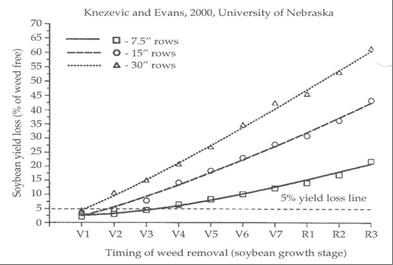Roundup Ready and LibertyLink soybean varieties have made weed control much simpler. In addition to being easier, we are generally doing a better job at controlling all weeds, especially those that could not be controlled well with traditional herbicides. Perennial weed control is especially better with glyphosate. However, weed resistant to glyphosate continues to get worse. To date, we have glyphosate resistance in marestail (horseweed), lambsquarters, Palmer amaranth, common ragweed, and johnsongrass in Virginia. To date, no resistance has been documented for glufosinate (Liberty or Ignite herbicides). I strongly encourage using preemergence residual herbicides with glyphosate and glufosinate, even in double-cropped soybean. With glyphosate, tank-mix partners are also in order due to the increasing weed resistance issue.
It is worth noting that glufosinate will not kill as big of weeds as glyphosate, nor is it as effective on grasses. To me, this may be an advantage of the LibertyLink program. Why? First, it almost requires one to put down a preemergence herbicide, if nothing else to buy one a little time for the subsequent postemergence glufosinate application. Secondly, you generally need to make the glufosinate application before the weeds reach 4 inches in height (height requirements depend on the weed to be controlled; see the label for weed-specific height requirements). While these two “advantages” may not seem to be advantages, they will help insure that weeds do not become resistant to glufosinate. In addition, if we let the weeds grow in competition with the soybean much longer, we’ll lose yield (see the discussion below).
On the other hand, since glyphosate will kill larger weeds that glufosinate, we tend to wait too late to spray. It has been shown that spraying weeds that are too large can encourage herbicide resistance. That in itself should make timely weed control a priority. But other than herbicide resistance, I see two main problems with relying on glyphosate weed control systems. First, we tend to spray later than we should because we want to kill all of the flushes of weeds with one spray. This is a mistake! As I said, glyphosate will kill larger weeds than most of our other postemergence herbicides. So, why not try to wait and only spray once? While that approach will save time and money if two applications would otherwise be necessary, it could be costing you more money in the long run by letting weeds rob the crop of essential light, water, and nutrients. The figure below shows the effect of weed competition with soybean as related to application timing and row spacing. In general, we need to spray our herbicides within 2 to 3 weeks after the weeds emerge. If we don’t, we’ll suffer the consequences of lower yields and possibly less control.
The second problem is related to the first. Weeds become more difficult to control the bigger they are, even with glyphosate. Most of our control failures (and glyphosate resistance problems) are due to allowing weeds to get too large. Weeds such as marestail, lambsquarters and morningglory are much more difficult to control when they are large. Again, spray within 2 to 3 weeks after weed emergence.
